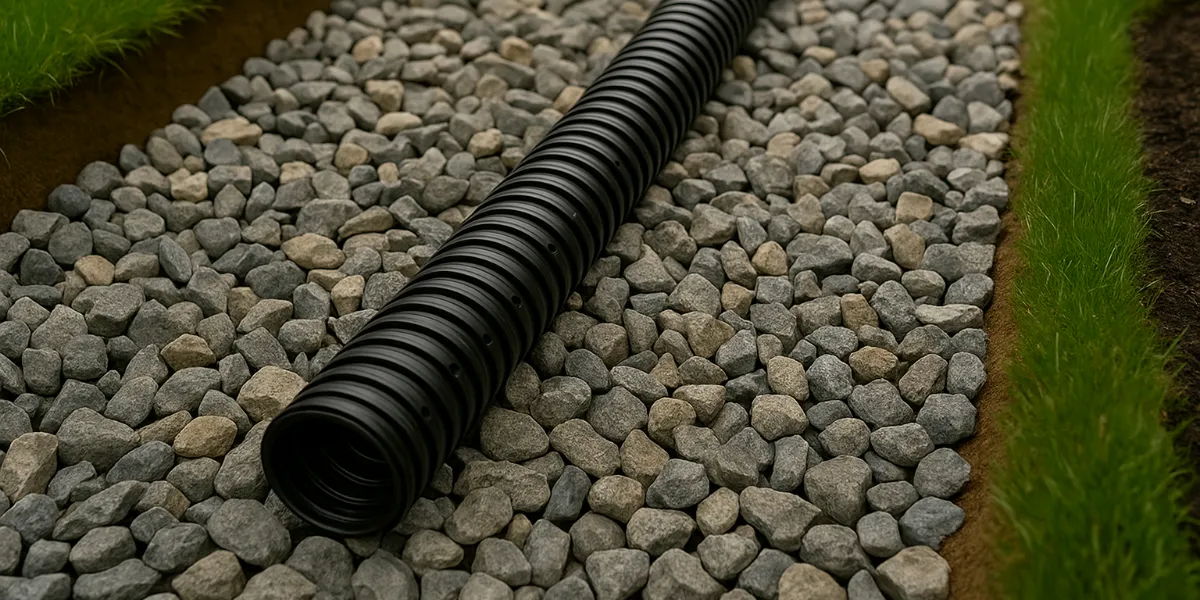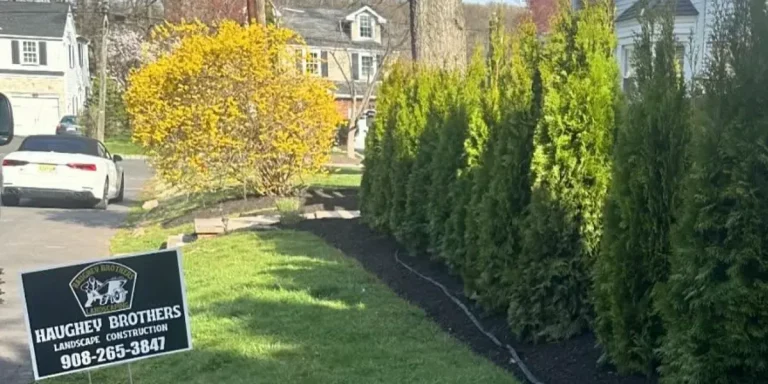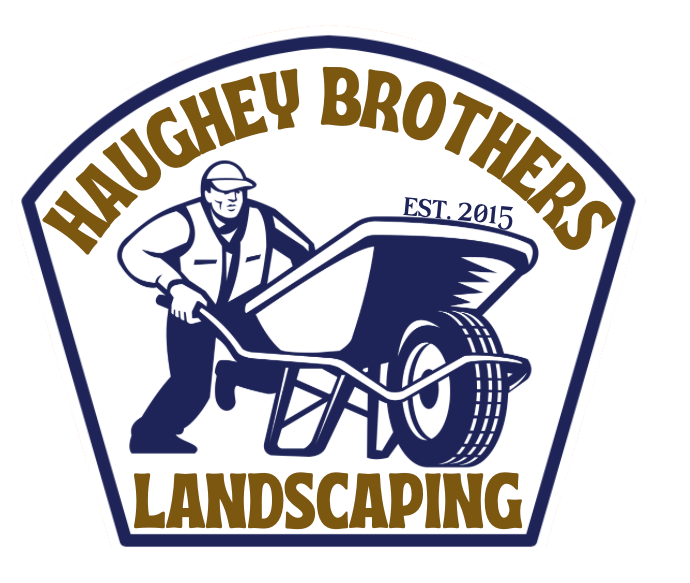Drainage Swales vs. French Drains: What to Choose

Not sure how to deal with standing water or soggy spots in your yard? You’re not alone. Drainage issues are one of the most common landscaping problems we solve for homeowners in Westfield and across Central New Jersey. Two of the most effective drainage solutions are swales and French drains—but knowing which one you need depends on how water moves through your property.
At Haughey Brothers Landscaping, we help homeowners identify the cause of their drainage problems and implement long-lasting solutions that protect their landscaping and home foundation. Here’s what you need to know before choosing between a swale and a French drain.
What Is a Drainage Swale?
A drainage swale is a gently sloped, shallow channel designed to manage surface water runoff. It’s typically carved into the landscape and can be lined with turf, gravel, stone, or even native vegetation to both slow the water and allow it to absorb into the ground. Unlike underground systems, a swale remains visible and functions as part of your landscape design.
The primary purpose of a swale is to redirect rainwater and prevent it from pooling near your foundation, flooding low spots, or washing out garden beds. Swales are commonly installed along property lines, at the base of hills, or adjacent to driveways and patios—anywhere water tends to collect and cause problems.
When properly graded and integrated into the terrain, swales can serve both a functional and aesthetic role. Some homeowners even choose to enhance them with decorative rock, ornamental grasses, or rain garden plantings to create a natural-looking feature that supports local ecology and improves curb appeal.
Drainage swales are ideal when:
-
- Your yard naturally slopes or could be reshaped to create gentle grading
- Water flows visibly across the surface during storms
- You want a low-maintenance, above-ground solution that supports soil absorption
- You prefer an eco-friendly system that filters runoff and reduces erosion
At Haughey Brothers Landscaping, we design swales that not only solve your water problems, but also fit seamlessly into your yard’s overall look and layout.
What Is a French Drain?
A French drain is a subsurface drainage system designed to remove excess water from saturated soil. It consists of a perforated pipe laid in a sloped trench, surrounded by gravel or stone that helps water filter into the pipe. The system then redirects that water away from problem areas—such as foundations, low-lying parts of the yard, or behind retaining walls—to a suitable outlet like a storm drain, dry well, or lower part of the property.
Unlike surface solutions like swales, French drains target water that moves below ground, making them the right choice for properties where moisture lingers long after it rains. These systems quietly do their job beneath the surface, helping to protect structures, stabilize soil, and prevent root rot in nearby plants.
French drains are especially effective when:
-
- You have persistent puddles or soggy soil even days after rain
- Water is seeping into your home’s basement, crawlspace, or slab foundation
- Your lawn has poor grading or flat areas that trap runoff
- The soil is clay-heavy and drains slowly
- You need an invisible solution that won’t alter your landscaping layout
Because French drains are hidden underground, they preserve the visual appearance of your yard while solving serious water problems. At Haughey Brothers Landscaping, we install French drains that are engineered for performance and longevity—helping protect your home and landscape from the long-term damage caused by excess moisture.
Swale vs. French Drain: Which Is Right for You?
While both swales and French drains are effective at managing excess water, they solve different types of drainage problems. At Haughey Brothers Landscaping, we assess your property’s unique conditions—soil type, slope, runoff patterns, and existing landscape features—to determine the most effective and lasting solution.
The right choice often comes down to whether you're dealing with surface runoff or subsurface saturation.
A swale is ideal if:
-
- Water is visibly flowing across the surface of your lawn or driveway
- Your property has a natural slope that can be used to direct water
- You want an above-ground solution that can be incorporated into your landscaping
- You’re looking for a low-maintenance and eco-friendly drainage fix
Swales are particularly effective for managing rainwater from roofs, driveways, or sloped lawns—and can often be disguised as part of your landscape design with grass, gravel, or decorative stone.
A French drain is ideal if:
-
- Water is pooling or soaking into the ground with no visible runoff
- You have flat, compacted, or clay-heavy soil that drains poorly
- Soggy spots in your yard never seem to dry, even days after rain
- Moisture is seeping into your basement, crawlspace, or foundation walls
- You prefer a hidden system that doesn’t change the look of your yard
French drains work quietly beneath the surface, intercepting water before it causes damage—and are especially valuable for protecting structures and preventing long-term moisture issues.
In some cases, both solutions work best together
For more complex properties, we often recommend combining both swales and French drains. For example, a swale might collect water running off a sloped lawn and direct it to a hidden French drain that safely carries it away from the house. This hybrid approach is especially useful when surface and subsurface issues overlap or when aesthetics and long-term protection are equally important.
At Haughey Brothers Landscaping, we design integrated drainage solutions that consider your entire landscape—not just the symptoms. Whether you're dealing with soggy soil, foundation seepage, or seasonal flooding, we’ll tailor a plan that keeps your yard dry and your property protected.
Our Approach to Drainage Solutions
At Haughey Brothers Landscaping, we start every drainage project with a comprehensive site evaluation. We look at:
-
- Water flow patterns
- Soil type and saturation
- Property slopes and elevation
- Existing landscaping and structures
From there, we create a custom plan that may include:
-
- Swale design and grading
- French drain installation
- Downspout extensions or catch basins
- Erosion control with mulch, plantings, or stone
- Regrading trouble areas
We use high-quality materials and proven installation techniques to ensure your drainage system performs through every season.
Real-World Example
One of our clients in New Providence had a flat backyard that turned into a swamp after every storm. We installed a combination system—a swale to guide surface water from the lawn, and a French drain to handle the underground saturation near the patio. The result? A dry, usable yard with no more standing water or foundation concerns.
Proudly Serving Central New Jersey
Haughey Brothers Landscaping provides expert drainage solutions in Westfield, NJ and throughout the surrounding area, including:
-
- Berkeley Heights
- Chatham
- Cranford
- Madison
- Mountainside
- New Providence
- Scotch Plains
- Short Hills
- Springfield
- Summit
- Westfield
Say Goodbye to Standing Water
Tired of water ruining your lawn or threatening your foundation?
Haughey Brothers Landscaping can help you choose the right drainage solution for your property. Whether it’s a swale, a French drain, or a combination system, we’ll design and install it for maximum performance and minimal disruption.
Call today or request an estimate online. We proudly serve homeowners across Union County with trusted drainage and landscaping services built to last.



